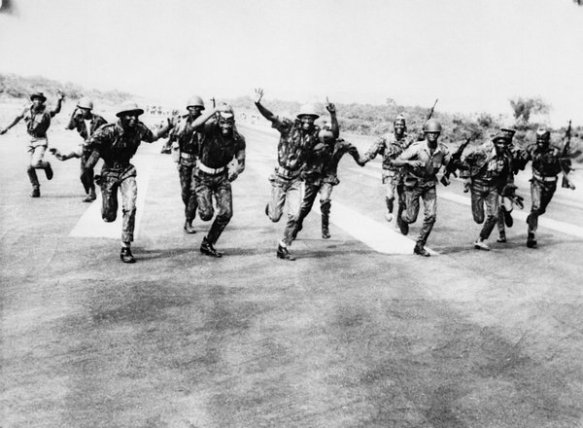Great Nigerian troops celebrating the surrender of Biafra at Uli airstrip.
Uli airstrip that handled the second highest number of flights in Africa in that period next to Johanesburg.
The Uli Airstrip was the most important link between Biafra and the outside world during the Nigerian civil war. Most of the major airfields in Biafra were captured by government forces early in the war. Had the Nigerian government destroyed the Uli Airstrip, the war and the humanitarian catastrophe that accompanied it probably would have ended very quickly. Unfortunately, the government was dependent on mercenary pilots who were skilled enough to target the airport at night. When mercenaries working for the government refused to destroy the airport, Biafra was able to continue its resistance (De St. Jorre 1972, 318).
Why were the mercenary pilots unwilling to strike an obvious military target? There are two basic reasons. First, the mercenaries working for the government knew that relief planes would be flying into the Uli Airstrip at night. It was not the cargo of these planes that concerned the mercenaries; instead, it was the pilots. Many of the pilots who transported relief supplies to Biafra were also mercenaries hired by various relief organizations. As many of the relief mercenaries had worked with the government mercenaries in the Congo, there was a gentlemen’s agreement that mercenaries would not intentionally target each other.
In addition, there was a basic financial incentive not to destroy the airport. Mercenaries from both sides knew that the end of the Uli Airstrip would mark the end of the rebellion. In this context, the destruction of Uli would have been bad for business. In the end, the rebels used the Uli Airstrip successfully until the last days of the war. Although the airstrip allowed valuable assistance to reach starving people, it also was a key factor in allowing the rebellion to last well beyond what most observers expected. The irony of Uli, as critical as it was to the final outcome, is one of the more poorly documented events of the war (De St. Jorre 1972).
The Relief Effort: Highs and Lows
The effects of both the war itself and the blockade imposed by the Nigerian government took a heavy toll on civilians in Biafra. As the war lingered on, the UNHCR estimated that more than 3 million children in Biafra were in danger of starving (Goetz 2001). In response to the crisis, several international relief organizations attempted to deliver food and supplies to civilians in Biafra. The relief effort had mixed results.
On the positive side, relief organizations delivered as much as 500 tons of food and supplies into Biafra daily in what became known as the Biafran Airlift. The size and scope of the relief effort was the largest undertaken since World War II (De St Jorre 1972, 238). Catholic and Protestant relief organizations, at times in coordination with the International Committee of the Red Cross (ICRC), were involved in the relief effort. It is clear that these supplies saved countless civilians from starvation.
At the same time, owing to both a lack of funds and a lack of supplies, smaller relief agencies were often forced to book space on the same aircraft that were smuggling arms into Biafra. The Nigerian government believed that arms shipments disguised as humanitarian aid shipments were a boon to the rebellion. The government placed a ban on nighttime flights in Biafra and shot down a Swedish ICRC aircraft. The ICRC made the critical mistake of sending the same negotiator to both sides of the dispute in an attempt to secure safe passage for relief flights. Each belligerent party suspected the ICRC of working for the other side (De St. Jorre, 1972; Goetz, 2001).
It is widely known that, in addition to arms transfers, mercenaries were a source of potential military strength for the secessionists. In the final analysis, however, mercenaries played a relatively small role in the war. Part of this was because the Biafran forces were suspicious of mercenaries after having fought against many of them as part of the Nigerian military contingent dispatched to fight in the Congo. In addition, many mercenaries were reluctant to come to Biafra because there was a distinct possibility that they would be called on to fight against “brothers in arms” hired by the government (De St. Jorre 1972, 313). Ironically, the main role played by mercenaries during the war may have been the failure of government mercenary pilots to destroy the makeshift Uli Airstrip, which was located about halfway between the cities Onitsha and Oguta.
